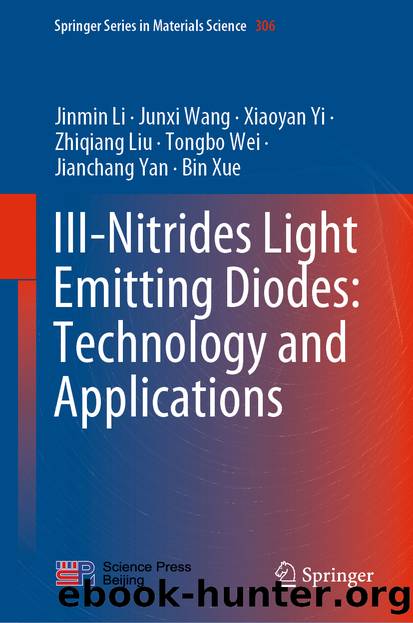III-Nitrides Light Emitting Diodes: Technology and Applications by Jinmin Li & Junxi Wang & Xiaoyan Yi & Zhiqiang Liu & Tongbo Wei & Jianchang Yan & Bin Xue

Author:Jinmin Li & Junxi Wang & Xiaoyan Yi & Zhiqiang Liu & Tongbo Wei & Jianchang Yan & Bin Xue
Language: eng
Format: epub
ISBN: 9789811579493
Publisher: Springer Singapore
7.4.3 Current Blocking Technique
There are many discussions about reasons of efficiency droop resulted from Auger recombination [30] and leakage of carriers [31, 32]. In localization in the quantum well is also considered [33]. But there is no mention of the efficiency droop caused by current distribution. From the previous calculation and analysis of the current distribution, it can be seen that the current distribution under the larger current is more uneven. The light absorption from the metal electrode can be large. All of these can lead to LED efficiency droop. The reason for the current fluctuation of the current injected into the multiple quantum wells in the chip changing with the increase of the injection current is that the PN junction dynamic resistance of the LED is not a fixed value which decreases with the increase of the current density. Therefore, the current spreading length in the current spreading layer of the LED is different under different injection currents which have been analyzed in the prior art.
On the other hand, the current density injected into different regions of the multiple quantum wells is different in practical LED devices. Different injection current densities will form different carrier concentrations in the quantum wells. In other words, the internal quantum efficiency is not the same at deferent carrier concentrations. Therefore, there are different internal quantum efficiencies in different regions of the chip. This also indicates that the overall efficiency of the device is related to the distribution of current density [34].
The function of the current blocking layer is to limit the injection current under the n electrode, where the light generated by this partially injected current is difficult to extract. Mathematically, the value of the second term of the denominator in the above formula is reduced to zero, thereby reducing the denominator and increasing the value of the fraction.
A vertical structure LED with a current blocking layer is also modeled to calculate its current distribution. The material structure and parameter of the model are the same as the vertical structure LED model above. Only the structure of the p electrode is changed as shown in Fig. 7.22
Fig. 7.22GaN-based vertical LED model with current blocking layer
Download
This site does not store any files on its server. We only index and link to content provided by other sites. Please contact the content providers to delete copyright contents if any and email us, we'll remove relevant links or contents immediately.
| Circuits | Digital Design |
| Electric Machinery & Motors | Electronics |
| Fiber Optics | Networks |
| Superconductivity |
Whiskies Galore by Ian Buxton(40304)
Introduction to Aircraft Design (Cambridge Aerospace Series) by John P. Fielding(32332)
Small Unmanned Fixed-wing Aircraft Design by Andrew J. Keane Andras Sobester James P. Scanlan & András Sóbester & James P. Scanlan(32137)
Craft Beer for the Homebrewer by Michael Agnew(17440)
Turbulence by E. J. Noyes(7033)
The Complete Stick Figure Physics Tutorials by Allen Sarah(6632)
Kaplan MCAT General Chemistry Review by Kaplan(6045)
The Thirst by Nesbo Jo(5779)
Bad Blood by John Carreyrou(5763)
Learning SQL by Alan Beaulieu(5400)
Weapons of Math Destruction by Cathy O'Neil(5032)
Man-made Catastrophes and Risk Information Concealment by Dmitry Chernov & Didier Sornette(4731)
iGen by Jean M. Twenge(4695)
Digital Minimalism by Cal Newport;(4512)
Life 3.0: Being Human in the Age of Artificial Intelligence by Tegmark Max(4496)
Audition by Ryu Murakami(4093)
1,001 ASVAB Practice Questions For Dummies by Powers Rod(4034)
Electronic Devices & Circuits by Jacob Millman & Christos C. Halkias(4021)
Pale Blue Dot by Carl Sagan(3997)
